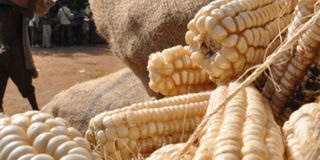Prime
Food wastage in Uganda: A social marketing perspective

Maize spread on the ground to dry in 2017. Research shows that poor harvesting, drying and storage of grains can lead to poisoning. PHOTO | FILE
What you need to know:
- Mr Fawz Manyaga observes that Uganda is paying a big price for producing food that is not eaten but wasted.
While food wastage has gained extensive research in policy adoption, its implementation has not cut across all levels. Uganda was known as the food basket for Africa right from the Idi Amin regime to around 2000’s.
Its imaginary name had attracted countries within Ecowas to get interest in importing food from Uganda, a move that would increase the country’s foreign exchange as well as expanding its market for agricultural produce.
However, as economic developments and administrative roles switched, the name ‘food basket for Africa’ started to lessen. Nevertheless, the country has been experiencing food losses contributed by a plethora of factors.
The countries’ net export over the years has greatly reduced by numbers and it has affected its market competitiveness specifically within the region. The problem of food waste is believed to start from poor pre-farming to post-harvesting practices within rural areas of the country. According to the Economic Policy Research Centre in Uganda, there are only eight warehouses where food is stored, and these are privately owned. Thus, we can posit that within these facilities, farmers are likely to face competition of getting shelves for proper storage of produce.
It should be noted that the condition of storage facilities and practices in Uganda is still conventional and obsolete. Local farmers, who can’t afford modern storage facilities, resort to the use of polythene bags that inherently make food to easily get contaminated. It is nevertheless estimated that around 50 percent of food is lost and has had remarkable repercussions for the country’s food supply capacity.
In this regard, farmers have lost food for sale, which in result forces prices of food to surge. Because the country had not prepared for natural disasters, the period of Covid-19 taught farmers a lesson to inhibit themselves with better ways of marketing as well as storage practices.
It is also estimated that farmers in western Uganda lost millions of cash because sweet bananas (matooke) got wasted following the ban of inter-district movements by the government. The move did not only hinder local consumers as international food markets plunged as flights were barred from docking unlike those carrying personal protective equipment’s. Research in academia has suggested that increase in food waste is attributed to health concerns. Recently in 2021, the Kenyan authorities banned maize from Uganda citing availability of aflatoxin that causes liver cancer and consequently unsafe for consumption.
The global food system alone is estimated to be responsible for about 39 percent of total greenhouse emissions.
Considering the proportion of food wasted in Uganda, there has been a big price paid as food produced is not eaten but wasted. Plenty of this food is not recycled and where it is not recycled, it ends up within lands, decomposes, and produces a substance called methane that is more dangerous than carbon dioxide. Although it is a common practice for hotels, restaurants, and households to provide wasted food to the needy and street children, there is a systematic potential of food wasted than just offering it to people.
The mentioned potential is- recycling food that is wasted from anaerobic digestion plants where organic materials are broken down to form microorganisms that later produce methane.
Since the government of Uganda hasn’t yet stabilised the supply of electricity within rural and urban areas, this can be a great opportunity to produce electricity from cheap reliable sources in areas where dams are not popular. Furthermore, the government can also utilise methane to turn it into fertilizers for farm produces since it contains a nutrient. Albeit existing food waste campaigns by government and local non-government organizations, these campaigns focus much on capacity building through information sharing than on cognitive aspects.
Government should develop a framework of campaigns targeting individual aspects that will stimulate person’s understanding of food waste and where necessary, to sieve the message in native languages.
From a social marketing perspective, the government of Uganda together with NGO’s should create an environment that transforms peoples thinking towards reducing food waste. After understanding the primary problem of food wastage and its implications, we can posit that food waste is done by a combination of individual (micro) and community (macro) in the event of not consuming food but fit for consumption. Governments around the world have been resilient to reducing food waste through creating food banks and supporting charities that support the needy.
The United States of America became the first government to set target to reduce food waste by 2030. The government also estimates that food waste costs are around 161.6 billion dollars per year.
The farmers of Uganda have lost value of their produce. These range from selling their produce at a low price than that of the global as well as regional market, ditching rotten food, and loosing local and international markets. It is here that I would like to remind the government to reconsider damages of food waste. The government of Uganda should set up modern public warehouse infrastructure that can store farmers produce especially within rural areas.
Produce prune to decay such as tomatoes and other fruits can be stored at a cheaper price within public stores installed by the government. Thus, in a social marketing perspective, the government gains revenues from the “storage fee” as well as farmers benefiting from their produce not decaying.
Through Naads and Naro, the government should leverage on available agricultural professionals to make research that will boost development of pesticides with a goal of controlling food losses along the supply chain of agricultural produce.
In addition, the government should also supply farmers with quality seeds to reduce losses that rather result from using poor quality of seeds. The government should nevertheless assist farmers by training them on the dangers of poor pre- and post-harvest practices, create markets for agricultural produce as well as increasing food waste campaigns in rural areas.
Lastly, the government through Unbs should enforce standards of pesticide, seeds that are imported within the country. This should be followed with providing certificates to farmers and store owners for meeting standards as well as increasing the activity of monitoring agronomists.
By putting these suggestions inconsideration, the government of Uganda can halt levels of food waste significantly by 2035.
Catalysts
According to a 2019 report by the Food and Agriculture Organization, annual post-harvest loss stands at 17.6 per cent for about 2.8 million metric tonnes (MT), 12.4 per cent of about 214,000MT and 13.5 per cent of 230,000MT of maize, millet and rice produced in the country respectively. According to government statistics, as high as 40 per cent of crop harvests in the country are lost due to poor post-harvest handling that food processing and storage fall under. Researchers at the National Agricultural Research Organisation (NARO) have indicated that poor post-harvest practices can lead to food loss and also cause contamination of grains and beans with aflatoxins. Studies by Partnership for Aflatoxin Control in Africa in 2017 revealed that Uganda’s maize, sorghum and groundnuts contained aflatoxin levels exceeding the national maximum limit.
Concerning trade competitiveness, Uganda has experienced scenarios where some food products have been rejected or barred from accessing some foreign markets due to safety concerns. Poor post-harvest handling leads to loss of quality and quantity of produce. This then limits the markets Ugandan goods would have accessed, resulting in the loss of revenue and income for the people down the chain.




